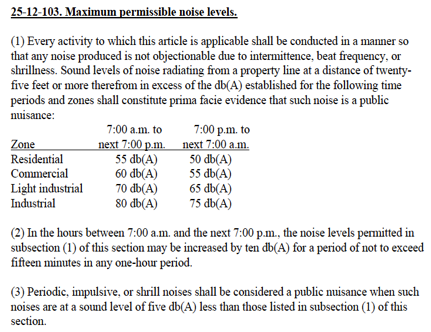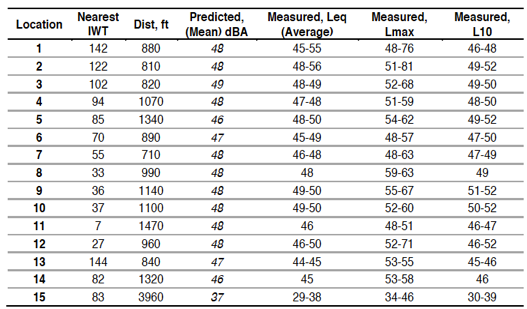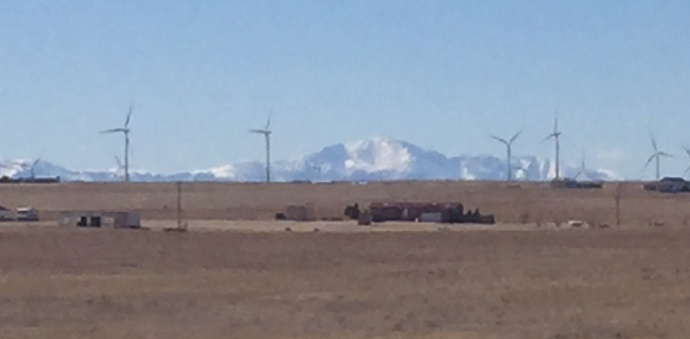By Kohl Watson with contributor Amy Cooke
Is the Golden-View Wind Farm in Calhan, Colorado out of compliance with state law and county requirements?
Since the industrial blades began spinning in 2015, residents have made 23 calls regarding noise levels from the industrial wind farm. Despite the numerous calls, which the El Paso County Sheriff’s Office acknowledges, a Colorado open records request revealed not a single written file or note on any of these reports.
In a March 26 meeting NextEra, which owns the Golden-West wind farm, testified in front of the El Paso County Board of County Commissioners (BOCC) that every turbine is within the legal sound threshold allowed by the state of Colorado. NextEra based its testimony on a BOCC required report that it commissioned from the Epsilon Associates, an environmental consulting group based in Massachusetts.
While every turbine by itself may be within the legal sound threshold, what about collectively? Golden-West is an industrial wind farm and when multiple units are spinning at the same time, they can violate state statute according to Robert Rand, an independent sound consultant and engineer. Rand testifies as an expert witness in local, state, and federal cases.
Several local Calhan residents hired the Boulder-based Rand to review the NextEra’s Epsilon report. According to Rand, noise violations do impact that 23 non-participating residences, residents that did not allow NextEra to build on their property, or build closer than the agreed upon distance of 1,320 feet.
Rand references Colorado State Statute Article 12-103, Maximum permissible noise levels. The statute states that in residential zones, where the Calhan wind farms is located, sound levels cannot be over 50 decibels from the hours of 7pm to 7am. In addition, according to sub-section (3) periodic and impulsive noises lower the maximum permissible noise levels to 45 decibels during these hours. Rand states that wind experts agree that industrial wind turbines produce what is considered periodic noise.

(State Statute, Article 12)
According the Epsilon report’s own data, 14 out of 15 locations exceed the allowed state sound levels at least 10 percent of the time. Even the conservative measured average exceeds the legal limit in 10 out of the 15 locations[1].
Rand also claims that the Epsilon report itself contains internal contradictions, omissions, and may have even been conducted improperly. For instance, the report states that not one non-participating property “will be exposed to sound levels over 50db”, and then displays data points that prove that this is not the case.

(Every location, except for location 15, has a measured maximum sound level over 50 decibels.)
Epsilon omitted in its report that state statute limits sound levels to 45 decibels for periodic sound between 7pm and 7am. While the county statute does not contain this addendum regarding periodic noise, El Paso is not a Home-rule county and therefore must submit to state law.
As far as how Epsilon conducted their study, Rand questions their methods. He contends that the study was conducted while only a few turbines were on, rather than all of them. Jeff Wolfe, a Calhan resident, presented video evidence at the BOCC meeting on March 26th. Wolfe is a non-participating resident whose property is only 1,351 feet from the wind turbines.
By not having all of the turbines on while testing sound levels, Epsilon may have measured lower decibel levels than are actually present when all turbines are functioning.
Further omissions from the report were any sound levels that were recorded remotely (without an attendant) and in excess of 50 decibels. Epsilon claimed that they were removing noise not associated with the turbine[2]. This prompted a question from Rand, “But how could they have known that the noise was not attributable to the turbines if no one was there to witness the measurements?”
Most troubling is that NextEra only complied with part of the BOCC resolution. The required report also was to include a noise impact component:
 (Resolution No. 15-55, section 17)
(Resolution No. 15-55, section 17)
While its contractor Epsilon did conduct a sound level study, it failed to conduct a sound impact study. The difference between the two studies is that sound level studies only measure decibel levels, while a sound impact study examines quality of life under elevated noise levels from industrial wind turbines.
The sound impact portion of the study is no small detail. We visited with some of the non-participating residents who say their quality of life has deteriorated significantly. The requirement was a crucial part of El Paso County Resolution 15-55 allowing NextEra to receive an overlay-zoning permit. And, yet, NextEra still received a permit to operate an industrial wind farm without fully complying with BOCC requirements and examining quality of life in the shadow of an industrial wind farm.
Rand lays the blame at the feet of the BOCC. The BOCC never should have granted NextEra the operating permit without a thorough sound impact study as required in the resolution.
Rand believes it’s time to hold NextEra accountable. “We are a nation of laws, without laws we are lawless”.
Source: https://www.dropbox.com/s/zbg4x02qoby1u7v/Rand_Review_Epsilon-4177-GoldenWest-170321.pdf?dl=0
Works Cited
Rand, Robert. “Review of Epsilon Report 4177.” Review of Epsilon Report. March 21, 2017.
[1] Robert Rand, “Review of Epsilon Report 4177”, (2017), 9.
[2] Robert Rand, “Review of Epsilon Report 4177”, (2017), 2.
Kohl Watson is a Future Leaders intern for the Energy Policy Center at the Independence Institute. Kohl previously served in the United States Army.







